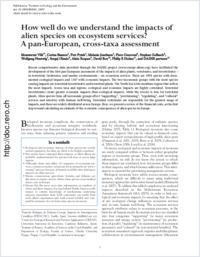How well do we understand the impacts of alien species on ecosystem services? A pan-European, cross-taxa assessment
- Vilà, Montserrat Estación Biológica de Doñana, Sevilla, Spain
- Basnou, Corina Center for Ecological Research and Forestry Applications (CREAF), Universitat Autònoma de Barcelona, Catalonia, Spain
- Pyšek, Petr Institute of Botany, Faculty of Science, Charles University Prague, Republic
- Josefsson, Melanie Department of Natural Resources, Swedish Environmental Protection Agency, Stockholm, Sweden
- Genovesi, Piero Institute of Environmental Protection and Research, Ozzano dell' Emilia, Italy
- Gollasch, Stephan GoConsult, Hamburg, Germany
- Nentwig, Wolfgang Zoological Institute, University of BernSwitzerland
- Olenin, Sergej Coastal Research and Planning Institute, University, Klaipeda, Lithuania
- Roques, Alain Institut National de la Recherche Agronomique, Orléans, France
- Roy, David Natural Environment Research Council, Centre for Ecology and Hydrology, Wallingford, Oxfordshire, UK
- Hulme, Philip E. The Bio-Protection Research Center, Lincoln University, Canterbury, New Zealand
- DAISIE partners List of DAISIE (Delivering Alien Invasive Species Inventories for Europe) project partners in WebPanel 1. Including Sven Bacher, Department of Biology, Ecology & Evolution Unit, University of Fribourg
-
2009
Published in:
- Frontiers in Ecology and the Environment. - 2010, vol. 8, no. 3, p. 135-144
English
Recent comprehensive data provided through the DAISIE project (www.europe-aliens.org) have facilitated the development of the first pan-European assessment of the impacts of alien plants, vertebrates, and invertebrates – in terrestrial, freshwater, and marine environments – on ecosystem services. There are 1094 species with documented ecological impacts and 1347 with economic impacts. The two taxonomic groups with the most species causing impacts are terrestrial invertebrates and terrestrial plants. The North Sea is the maritime region that suffers the most impacts. Across taxa and regions, ecological and economic impacts are highly correlated. Terrestrial invertebrates create greater economic impacts than ecological impacts, while the reverse is true for terrestrial plants. Alien species from all taxonomic groups affect “supporting”, “provisioning”, “regulating”, and “cultural” services and interfere with human well-being. Terrestrial vertebrates are responsible for the greatest range of impacts, and these are widely distributed across Europe. Here, we present a review of the financial costs, as the first step toward calculating an estimate of the economic consequences of alien species in Europe.
- Faculty
- Faculté des sciences et de médecine
- Department
- Département de Biologie
- Language
-
- English
- Classification
- Biology, life sciences
- License
-
License undefined
- Identifiers
-
- RERO DOC 12938
- DOI 10.1890/080083
- Persistent URL
- https://folia.unifr.ch/unifr/documents/301252
Statistics
Document views: 168
File downloads:
- pdf: 554
